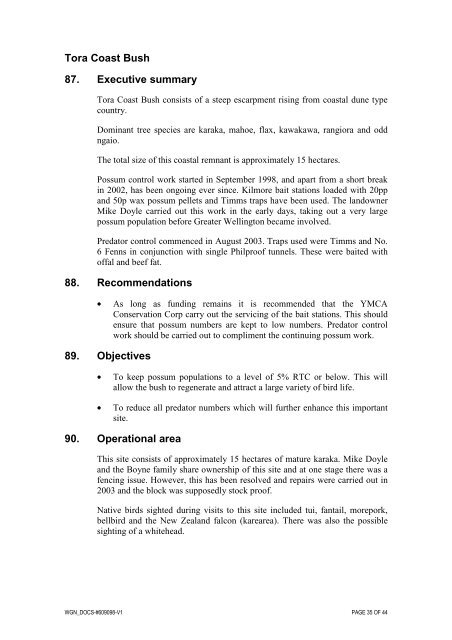Wairarapa Key Native Ecosystem Management Areas - Greater ...
Wairarapa Key Native Ecosystem Management Areas - Greater ...
Wairarapa Key Native Ecosystem Management Areas - Greater ...
You also want an ePaper? Increase the reach of your titles
YUMPU automatically turns print PDFs into web optimized ePapers that Google loves.
Tora Coast Bush<br />
87. Executive summary<br />
Tora Coast Bush consists of a steep escarpment rising from coastal dune type<br />
country.<br />
Dominant tree species are karaka, mahoe, flax, kawakawa, rangiora and odd<br />
ngaio.<br />
The total size of this coastal remnant is approximately 15 hectares.<br />
Possum control work started in September 1998, and apart from a short break<br />
in 2002, has been ongoing ever since. Kilmore bait stations loaded with 20pp<br />
and 50p wax possum pellets and Timms traps have been used. The landowner<br />
Mike Doyle carried out this work in the early days, taking out a very large<br />
possum population before <strong>Greater</strong> Wellington became involved.<br />
Predator control commenced in August 2003. Traps used were Timms and No.<br />
6 Fenns in conjunction with single Philproof tunnels. These were baited with<br />
offal and beef fat.<br />
88. Recommendations<br />
• As long as funding remains it is recommended that the YMCA<br />
Conservation Corp carry out the servicing of the bait stations. This should<br />
ensure that possum numbers are kept to low numbers. Predator control<br />
work should be carried out to compliment the continuing possum work.<br />
89. Objectives<br />
• To keep possum populations to a level of 5% RTC or below. This will<br />
allow the bush to regenerate and attract a large variety of bird life.<br />
• To reduce all predator numbers which will further enhance this important<br />
site.<br />
90. Operational area<br />
This site consists of approximately 15 hectares of mature karaka. Mike Doyle<br />
and the Boyne family share ownership of this site and at one stage there was a<br />
fencing issue. However, this has been resolved and repairs were carried out in<br />
2003 and the block was supposedly stock proof.<br />
<strong>Native</strong> birds sighted during visits to this site included tui, fantail, morepork,<br />
bellbird and the New Zealand falcon (karearea). There was also the possible<br />
sighting of a whitehead.<br />
WGN_DOCS-#609098-V1 PAGE 35 OF 44
















